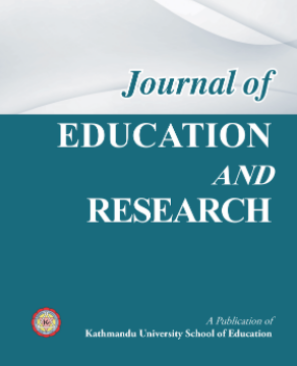
The Politics of Education Policymaking in Nepal
Editorial
Journal of Education and Research, Volume 9, Issue 1, 2019, 1-12, https://doi.org/10.3126/jer.v9i1.28787
Publication date: Mar 15, 2019
Views: 788 | Downloads: 618
How to cite this article
APA
In-text citation: (Dhakal, 2019)
Reference: Dhakal, R. K. (2019). The Politics of Education Policymaking in Nepal. Journal of Education and Research, 9(1), 1-12. https://doi.org/10.3126/jer.v9i1.28787
Reference: Dhakal, R. K. (2019). The Politics of Education Policymaking in Nepal. Journal of Education and Research, 9(1), 1-12. https://doi.org/10.3126/jer.v9i1.28787
Vancouver
In-text citation: (1), (2), (3), etc.
Reference: Dhakal RK. The Politics of Education Policymaking in Nepal. Journal of Education and Research. 2019;9(1):1-12. https://doi.org/10.3126/jer.v9i1.28787
Reference: Dhakal RK. The Politics of Education Policymaking in Nepal. Journal of Education and Research. 2019;9(1):1-12. https://doi.org/10.3126/jer.v9i1.28787
AMA
In-text citation: (1), (2), (3), etc.
Reference: Dhakal RK. The Politics of Education Policymaking in Nepal. Journal of Education and Research. 2019;9(1), 1-12. https://doi.org/10.3126/jer.v9i1.28787
Reference: Dhakal RK. The Politics of Education Policymaking in Nepal. Journal of Education and Research. 2019;9(1), 1-12. https://doi.org/10.3126/jer.v9i1.28787
Chicago
In-text citation: (Dhakal, 2019)
Reference: Dhakal, Rebat Kumar. "The Politics of Education Policymaking in Nepal". Journal of Education and Research 2019 9 no. 1 (2019): 1-12. https://doi.org/10.3126/jer.v9i1.28787
Reference: Dhakal, Rebat Kumar. "The Politics of Education Policymaking in Nepal". Journal of Education and Research 2019 9 no. 1 (2019): 1-12. https://doi.org/10.3126/jer.v9i1.28787
Harvard
In-text citation: (Dhakal, 2019)
Reference: Dhakal, R. K. (2019). The Politics of Education Policymaking in Nepal. Journal of Education and Research, 9(1), pp. 1-12. https://doi.org/10.3126/jer.v9i1.28787
Reference: Dhakal, R. K. (2019). The Politics of Education Policymaking in Nepal. Journal of Education and Research, 9(1), pp. 1-12. https://doi.org/10.3126/jer.v9i1.28787
MLA
In-text citation: (Dhakal, 2019)
Reference: Dhakal, Rebat Kumar "The Politics of Education Policymaking in Nepal". Journal of Education and Research, vol. 9, no. 1, 2019, pp. 1-12. https://doi.org/10.3126/jer.v9i1.28787
Reference: Dhakal, Rebat Kumar "The Politics of Education Policymaking in Nepal". Journal of Education and Research, vol. 9, no. 1, 2019, pp. 1-12. https://doi.org/10.3126/jer.v9i1.28787
ABSTRACT
I begin this editorial with an assertion that the contemporary public policymaking landscape in Nepal shows little citizens’ participation and thus education policymaking also bears a similar approach. Here, public policies refer to “the decisions and actions of government and the intentions that determine those decisions and actions” (Geurts, 2011, p. 6). Theoretically, governments across the globe in recent decades have committed for larger citizen participation in public policymaking. Therefore, I understand public policymaking as a phenomenon in which wider stakeholders engage in governmental decision-making processes aimed at addressing a public issue.
KEYWORDS
REFERENCES
---
LICENSE
This work is licensed under a Creative Commons Attribution 4.0 International License.
